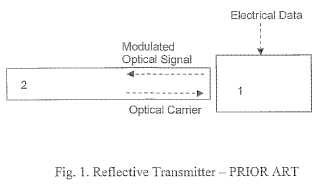A reflective optical transmitter
A semiconductor optical amplifier (SOA) is used in a double pass configuration with one of the output ports followed by an attenuator, which is followed by a modulator with a reflective facet. The variable loss between the SOA and the modulator is optimised, so that the SOA can be operated in a highly saturated regime without distorting the modulated signal. The SOA is firstly saturated by the input carrier, (21) in Fig. 2, which has a constant power and hence does not introduce patterning of the SOA gain. On the contrary the saturation induced by the carrier creates a clamping effect that prevents patterning for signals with input power comparable with or less than the input optical carrier power. The optical carrier amplified by the SOA (22) then travels through the attenuator section and it is attenuated (23). The carrier (23) then enters the modulator section where it is modulated with the data signal (24). After being reflected by the high reflectivity facet the modulated signal (25) propagates again through the modulator section. If the modulator section length is short compared to the modulation bit rate, the double passing increases the modulation depth or extinction ratio without introducing distortion. The modulated signal (26) travels a second time through the attenuator and then enters the SOA (27).Attached files:

Patents:
IE 20,090,412
Inventor(s): TOWNSEND PAUL DAVID [IE]; TALLI GIUSEPPE [IE]; MACHALE EIMEAR [IE]
Type of Offer: Sale
« More Communications Patents
